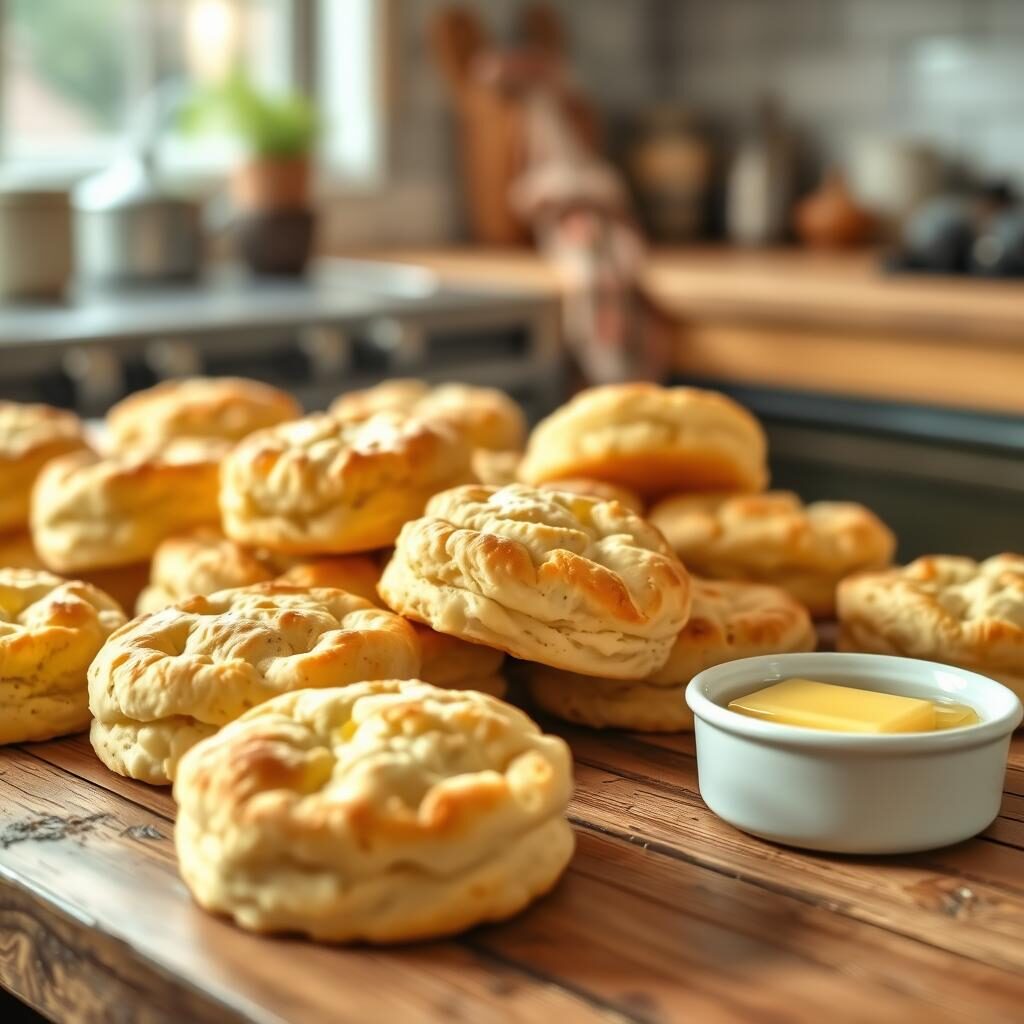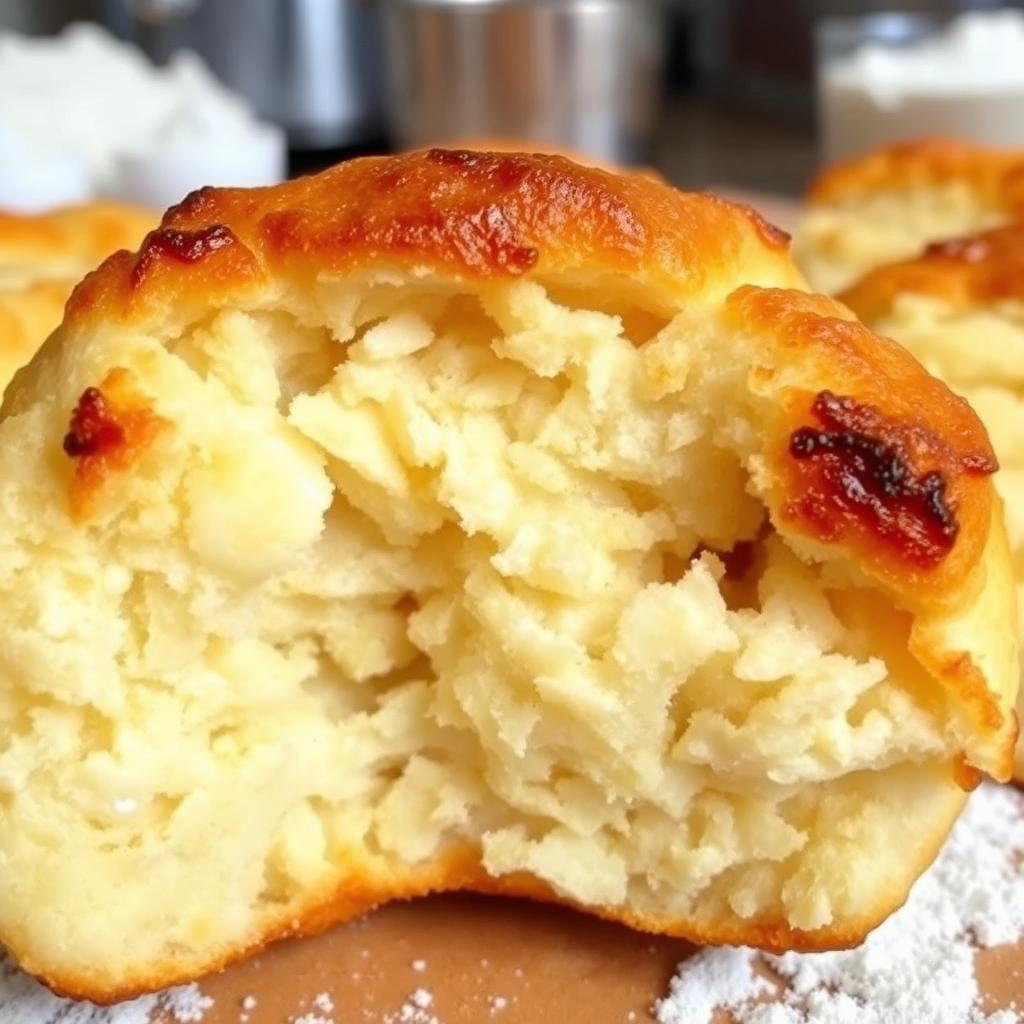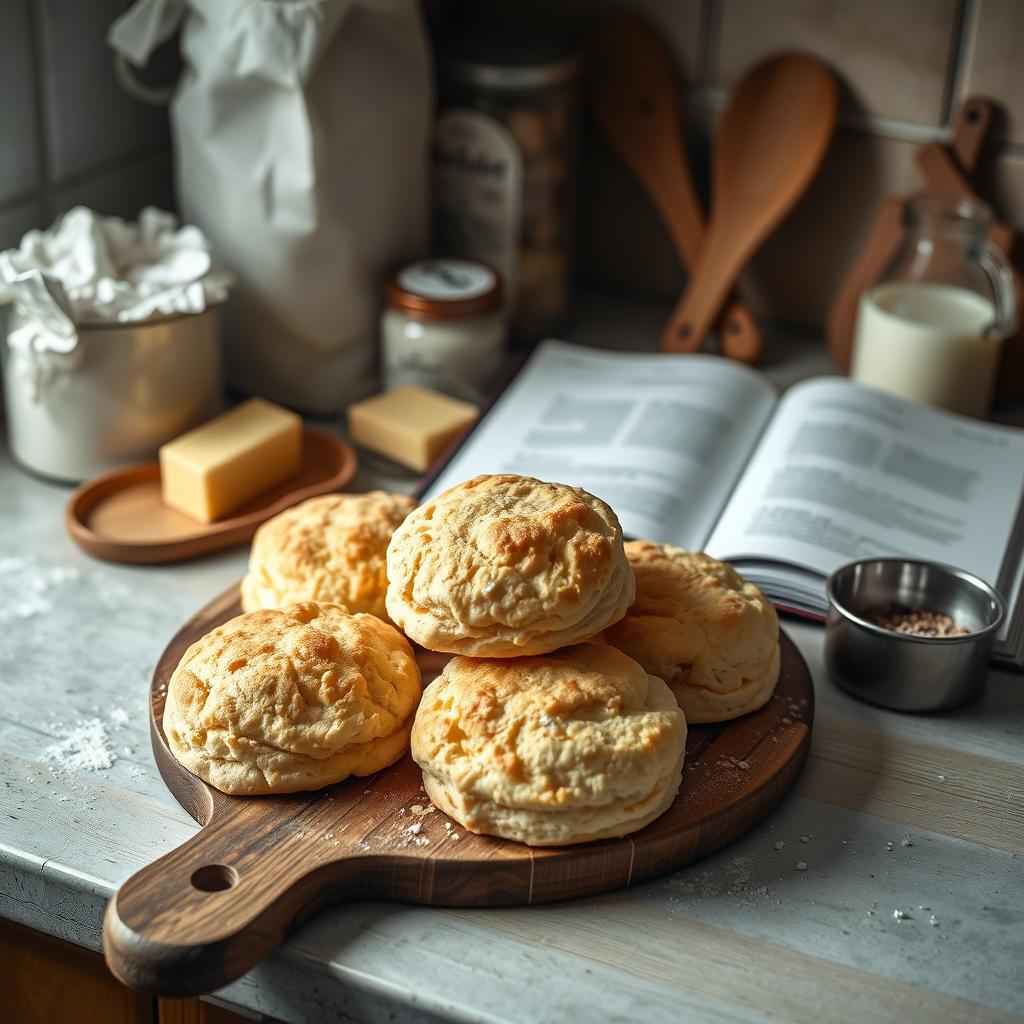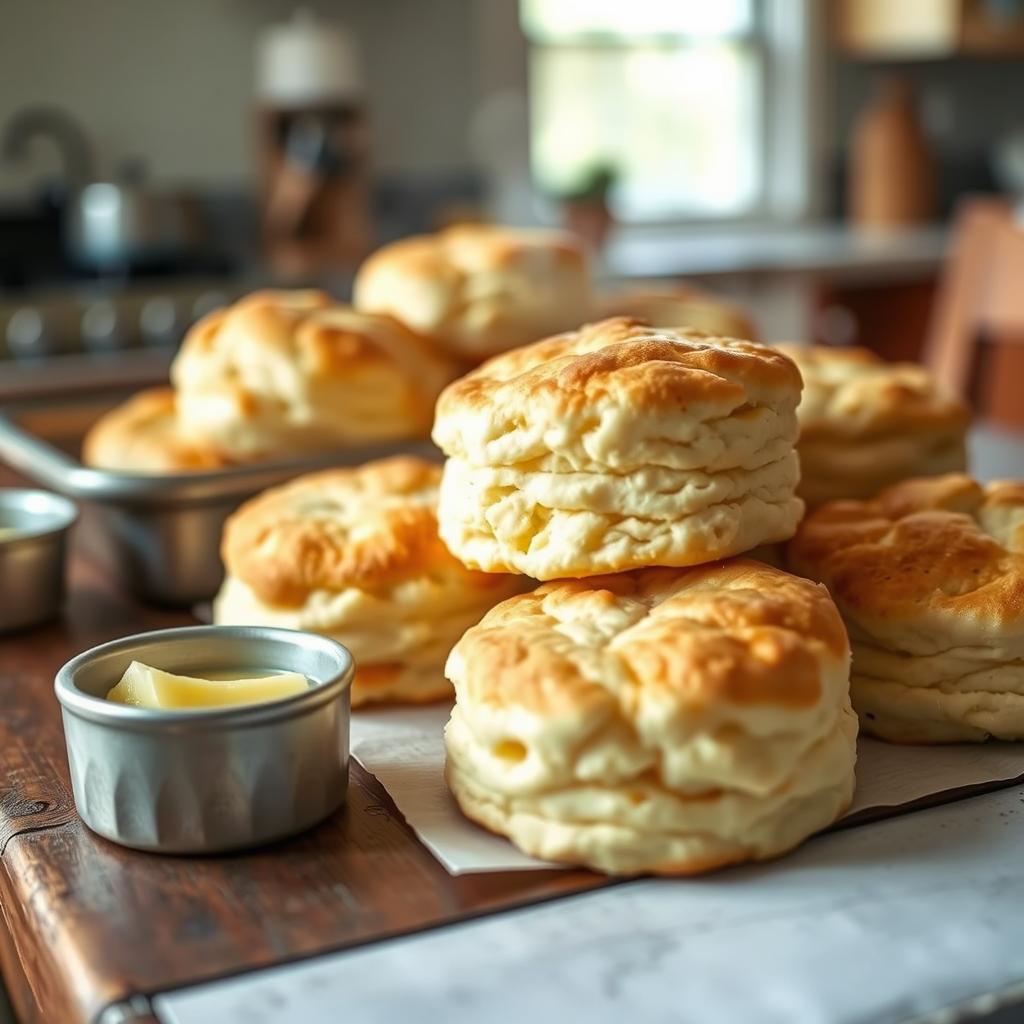Ever pulled out a batch of Bisquick biscuits from the oven, only to find them dry and crumbly? I’ve been there too. It’s frustrating when we want those tender, flaky biscuits but they don’t turn out right. But don’t worry, there are quick fixes to make your Bisquick biscuits moist and delicious every time.
In this guide, we’ll explore why Bisquick biscuits can be dry. We’ll also cover common mistakes that lead to dry biscuits. And we’ll share essential tips and techniques to bake moist Bisquick biscuits. Say goodbye to dry biscuits and hello to baking success!

Key Takeaways
- Understanding the role of fat content, liquid-to-dry ratio, and temperature in achieving the perfect biscuit texture.
- Identifying and avoiding common mistakes like overmixing, incorrect measuring, and oven temperature issues.
- Mastering the art of proper mixing techniques, including folding methods, optimal dough consistency, and handling time considerations.
- Exploring moisture-boosting ingredient additions, such as butter enhancements and dairy product variations.
- Uncovering temperature and timing secrets for baking flawless Bisquick biscuits every time.
Understanding the Science Behind Bisquick Biscuit Moisture
Baking tender and moist biscuits is an art that requires understanding the underlying science. The perfect Bisquick biscuit depends on several key factors. These include the role of fat content, the liquid-to-dry ratio, and the impact of temperature on moisture retention.
Role of Fat Content in Biscuit Texture
The amount of fat, whether butter, shortening, or another type, is crucial. Fats make the biscuits rich, flaky, and tender by tenderizing the gluten in the flour. Enough fat helps keep the biscuits moist, preventing them from becoming dry and crumbly.
Impact of Liquid-to-Dry Ratio
Getting the right balance between liquid and dry ingredients is key for moist Bisquick biscuits. If the ratio is off, biscuits can be too dry or too dense. Adjusting the amount of milk, water, or other liquids can greatly affect the texture.
Temperature Effects on Moisture Retention
The oven temperature is vital for the moisture content of your Bisquick biscuits. Baking at the correct temperature helps the biscuits rise and stay tender. But, overbaking or underbaking can make them dry and crumbly.
By understanding these scientific principles, you can improve your baking techniques. This will help you achieve the perfect Bisquick biscuits every time. They will be moist and delicious, delighting your taste buds.

Why Are My Bisquick Biscuits Dry?
If your Bisquick biscuits are dry and crumbly, there might be a few reasons. The secret to soft, flaky biscuits is finding the right mix of ingredients. Also, mastering how to mix and bake is key. Let’s look at why biscuits might be dry and how to fix it.
Ingredient Ratios
One big reason for dry biscuits is not the right mix of wet and dry ingredients. Bisquick is a mix, but adding too little liquid can make biscuits dry. Too little liquid makes the dough thick and dry, leading to biscuits that are not moist or flaky.
Mixing Techniques
Mixing the dough too much can also make biscuits dry. Overmixing makes the dough tough and dense. To avoid this, mix the ingredients gently and lightly, without overworking the dough.
Baking Conditions
The way you bake can also affect your biscuits’ moisture. If the oven is too hot or you bake them too long, the outside gets dry. But the inside stays soft. Make sure to follow the baking time and temperature to get moist, flaky biscuits.
By fixing these common problems, you can make your Bisquick biscuits soft and tasty. It’s all about the right mix, gentle mixing, and careful baking.

Common Mistakes That Lead to Dry Biscuits
Baking Bisquick biscuits is an art. Even a small mistake can make them dry and crumbly. It’s important to avoid these common mistakes to get the right texture.
Overmixing the Dough
Overmixing is a big mistake. It makes the biscuits tough and dry. Mix the dough gently, just until it comes together. Don’t overwork it.
Incorrect Measuring Techniques
Getting the measurements right is key. Wrong measurements can make the biscuits dry. Use the right tools and techniques for the perfect mix.
Oven Temperature Issues
The oven temperature is also crucial. Too hot, and the biscuits dry out. Too cold, and they don’t rise right. Use an oven thermometer to get it just right.
By avoiding these mistakes, you can make moist and flaky Bisquick biscuits every time.
Essential Ingredients for Moist Bisquick Biscuits
Creating moist and tasty Bisquick biscuits starts with the right ingredients. Having the correct biscuit ingredients is key to baking light and tender biscuits every time.
High-quality, fresh Bisquick mix is crucial. The mix’s makeup greatly affects your biscuits’ texture and moisture. Choose a Bisquick mix that’s not past its expiration date for the best results.
- Use cold, cubed butter or shortening for a flakier, tender crumb.
- Full-fat dairy like milk or buttermilk adds moisture and richness.
- A little sugar or honey can balance flavors and prevent dryness.
- Try alternative liquids like sour cream or yogurt for a special bisquick recipe twist.
By carefully choosing and mixing these biscuit ingredients, you’re on your way to making moist, irresistible Bisquick biscuits. They’ll surely impress your family and guests.
“The secret to moist, flavorful Bisquick biscuits lies in the quality and combination of your ingredients.”
Proper Mixing Techniques for Perfect Texture
Getting the perfect biscuit texture starts with mixing skills. The secret to flaky, light biscuits is in how you mix the dough. Learning the right techniques will help you bake biscuits with the perfect texture.
Folding Methods for Flaky Layers
To get those flaky layers, try folding the dough. Fold it in half, then in half again, before cutting out your biscuits. This method builds the gluten and traps air, making the biscuits delicate and flaky.
Optimal Dough Consistency
The dough’s consistency is key for the biscuit’s texture. You want it soft and slightly sticky, holding its shape but not too dry or tough. Overworking the dough makes biscuits tough, so mix gently.
Handling Time Considerations
Keep handling time short to keep the biscuit texture perfect. Don’t overwork the dough, as it can ruin the flaky layers. Mix ingredients just until combined, then handle the dough lightly when shaping and cutting.
Mastering these mixing techniques will help you bake Bisquick biscuits with a wonderful texture. Your family and friends will love them.
Temperature and Timing Secrets for Baking
To make Bisquick biscuits moist and flaky, you need to get the temperature and timing right. First, preheat your oven to 450°F (232°C). Let it heat up fully before putting in your biscuits.
The baking time for Bisquick biscuits is usually 12 to 15 minutes. But, it can change based on your oven, biscuit size, and recipe. Keep an eye on them to make sure they’re done just right. Try not to open the oven door too often to keep the temperature steady.
To get even browning, rotate the baking sheet halfway through. Using a baking stone or steel can also help. It promotes even heat and gives your biscuits a golden crust. Check out more baking tips and bisquick baking secrets.
| Oven Temperature | Baking Time | Moisture Retention |
|---|---|---|
| 450°F (232°C) | 12-15 minutes | High |
| 400°F (204°C) | 16-20 minutes | Moderate |
| 375°F (191°C) | 20-25 minutes | Low |
Mastering temperature and timing for Bisquick biscuits will help you make delicious, tender-yet-crisp treats every time.
Moisture-Boosting Ingredient Additions
Getting the right texture in Bisquick biscuits is all about a few key ingredients. Adding butter, different dairy products, and alternative liquids can make a big difference. These tips will help you make your Bisquick biscuits even better.
Butter Enhancement Methods
Butter is essential for Bisquick biscuits, giving them a rich, flaky texture. To add more moisture, mix in some cream cheese or sour cream. These ingredients make the biscuits creamy and tender, keeping them moist while baking.
Dairy Product Variations
Trying different dairy products can also enhance your biscuits. Use buttermilk or yogurt instead of regular milk. These alternatives add a tangy flavor and extra richness, improving the biscuit’s texture.
Alternative Liquid Options
For a richer biscuit, try using melted butter or heavy cream instead of milk or water. These liquids add moisture and make the biscuits tender and flaky.
Adding these ingredients can take your Bisquick biscuits to the next level. Experiment with different combinations to find the perfect mix for your taste and baking needs.
Storage Tips to Maintain Biscuit Freshness
Keeping your homemade Bisquick biscuits moist and flaky is crucial. The right storage can prevent them from drying out. Here are some tips to keep your biscuits fresh and tasty for longer.
Short-Term Storage
For biscuits you plan to eat within a day or two, store them at room temperature. Use an airtight container or resealable plastic bag. This keeps the moisture in and prevents drying out. Don’t refrigerate them right after baking, as cold air can make them hard.
Longer-Term Storage
To store biscuits for longer, freeze them. Cool the biscuits completely, then freeze them in a single layer on a baking sheet. Once frozen, put them in an airtight container or freezer bag. This way, they stay fresh for up to 2-3 months.
Reheating Tips
To reheat frozen biscuits, preheat your oven to 350°F (175°C). Place the biscuits in the oven for 5-10 minutes, until they’re warm. This helps them stay soft and prevents them from getting tough.
By using these baking tips, your Bisquick biscuits will stay moist and flaky. Enjoy them from the oven to the last bite.
Troubleshooting Other Common Bisquick Issues
While dryness is a common concern when baking with Bisquick, other issues can pop up. If your Bisquick biscuits are dense or don’t rise as expected, a few tweaks can fix them. Also, if they bake unevenly, you might need to adjust your baking method.
To get a lighter biscuit, avoid overmixing the bisquick baking dough. Fold it gently and handle it minimally to keep the layers soft. Also, check the liquid-to-dry ratio. Too little liquid can make biscuits dense and dry. Try adding more milk or dairy to make them fluffier.
If your biscuits don’t rise, it might be the baking powder or baking soda. Make sure these are fresh and not expired. Also, ensure your oven is at the right temperature. This is key for biscuits to puff up and get that fluffy texture. Adjusting the oven temperature or baking time might solve uneven baking or browning problems.

